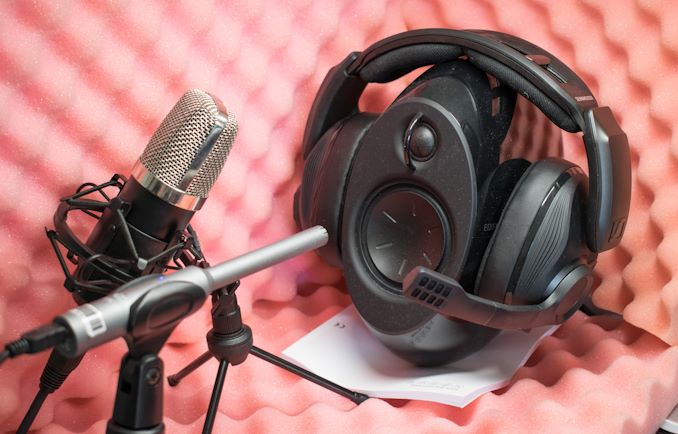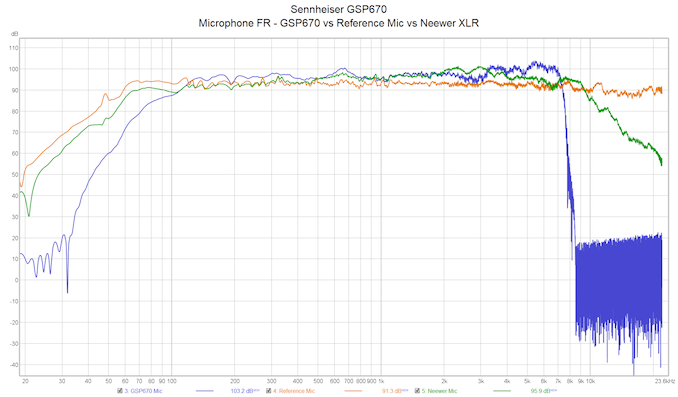The Sennheiser GSP670 Wireless Gaming Headset Review: Cutting The Cord
by Andrei Frumusanu on July 5, 2019 8:00 AM EST- Posted in
- Gaming
- Headset
- Audio
- Sennheiser
- GSP670
Microphone Testing
Obviously enough, because this is a full headset we also have to take a look at the microphone performance.
My test setup for this was relatively ghetto as I wanted to get good repeatability and consistency. I used one of my main speakers as the audio source as the GSP670’s fitted nicely over it. I calibrated the speaker’s frequency response to be as flat as possible from the recording distance, and also included measurements from a calibrated reference measurement microphone as well as my cheap 13€ Neewer XLR mic with my cheap audio interface.
In terms of frequency response, it largely corresponds to what Sennheiser reports: 10Hz to 7KHz. Now this isn’t really a great FR for a microphone, and the particularly steep drop-off after 7KHz is very audible in the audio quality.
Again for the sake of repeatability, I opted for a recording of a playback on the above setup. Sir Patrick Stewart will have to make due for us (Credit: GameStorys YouTube clip of Castlevania: Lords of Shadow).
Unfortunately, the quality really isn’t the best and there’s an obvious lack of clarity due to the limited frequency range.
The fact that the GSP670 performs quite a lot worse than my 13€ mic is a bit shameful for Sennheiser. I don’t quite understand why the company had limited the frequency range on the new headphones to just 7KHz while the predecessor GSP600 has a fuller frequency range till 15KHz. Would this be actually meant in some way to improve competitive gaming by not interfering with the higher end treble and to not miss any enemies?
In any case, I don’t like it, and it’s a damn shame Sennheiser even puts this on the market.












29 Comments
View All Comments
bunkle - Friday, July 5, 2019 - link
Agreed. There are many closed circumaural headphones that sound great. I use a closed backed Beyerdynamics DT 150 but there are many more depending on your taste: https://diyaudioheaven.wordpress.com/BenSkywalker - Friday, July 5, 2019 - link
Has there ever been a closed can that sounded better than an all else identical open one? Ever?Yes, a good set of closed cans will sound better than garbage open ones, but all else equal I've yet to see an example where the open headphone was not markedly superior.
bunkle - Friday, July 5, 2019 - link
"Sounds better" is highly subjective sweeping generalization but you certainly get closed headphones that have similar frequency response, distortion and harmonics up there with the best open backs. A nice example is the MrSpeakers Aeon that comes open and closed. Again completely subjective whether the closed "sounds better" but it's well regarded.whyaname - Friday, July 5, 2019 - link
I made an account just to reply to this.Sony R10
Apparently the best dynamic closed headphone ever made.
If you read about them, they are often compared to even the best electrostatic headphones there are.
They have the "advantage" of being closed and thus isolating the listener from unwanted background noise.
Sony only produced from what I remember roughly 2000 units as they apparently made a losswith every sold unit as it was a more of a "look we can" than "this exists to actually make money" kinda thing.
They developed together a biotech company a bacteria that produced the biocellose that was used for those cans.
Lots of other over the top stuff for them.
I really would like to get the chance to listen to a pair, but they are just that rare.
I read that someone that bought them back in the day in england had some higher up from Sony personaly deliver the headphone.
ZolaIII - Saturday, July 6, 2019 - link
Sony in the particular case used organic diagrams that ware approximately an order of magnitude thinner than usual & much more elastic but the same material would simply be to fragile for a open design. It always whose a very hard task to achieve a good implementation even with big resonance boxes for speakers involving additional barriers it's an art to be more precise. Same simply can't be used on headphones.iamlilysdad - Monday, July 8, 2019 - link
Did they make an open version of the R10 to compare the closed version to? If not, then that does not answer the question.The closest comparison I can think of the Sennheiser 800s compared to the 820. Open and closed of the same headphone.
BenSkywalker - Friday, July 5, 2019 - link
Air pressure?Either your headphones don't isolate so you get proper airflow, or they do isolate and you get echo/reverb issues.
ZolaIII - Saturday, July 6, 2019 - link
Simple as it is drivers need to dance (actually diagrams do). When ordinary materials used it's much easier to secure more optimal ripples with something that has a air flow than with something that is siled up. I prefer semi open back over the ear headphones. There are examples of closed back headphones which achieve outstanding bas (where cans need to dance the most) but those are rare (MEE 6 Pro being the last surprising one's in my case even more because those are tiny in ear [achieved true dancing driver]), they simply cannot have the sound stage as wide as open one's equally made.astrocramp - Saturday, July 6, 2019 - link
I prefer open back also, with one huge advantage other than sound that you can hear what's going on around you. I use Audiotechnica for gaming, but I don't think I've ever seen a wireless open back headset outside of the real expensive wireless audiophile Sennheisers (with no mic).willis936 - Friday, July 5, 2019 - link
Excellent work. It would be cool to see phase plots for latency measurements in future wireless testing. I’m not sure if test software is capable of sending samples to two drivers at the same time, as that would be important.